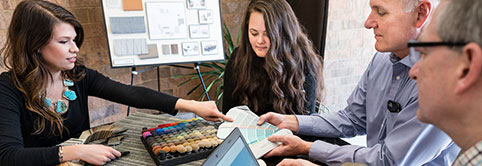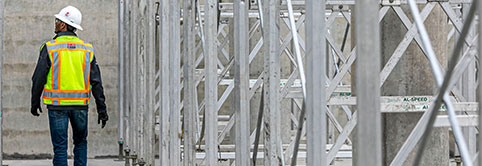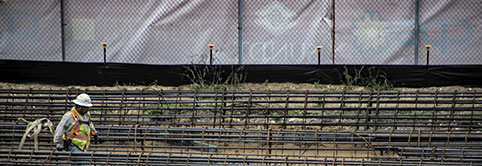Optimize the Whole
Introduction to Optimize the Whole
During construction projects using traditional project delivery methods, workers can get tunnel vision, focusing so intensely on their own individual work that they fail to see the project as a whole. In these projects, workers mostly just want to get in, get out, and move on to the next job. This is the way the industry has always been, and without intentional action it is unlikely to change.
In fact, there hasn’t been much motivation to change. In most cases workers have no reason to look beyond their own scope of work – their contracts are constructed in a way that only incentivizes them for completing their own work and not necessarily on the final outcome of the project. Or perhaps they haven’t seen the improvements that can be made when one looks outside of their own niche in the project.
This mindset can lead a worker to seeing a problem on the jobsite and shrugging it away with a “not my problem” mentality. This can be incredibly damaging for the success of a project.
Lean Construction aims to flip this mindset by shifting the focus of workers to one in which they Optimize the Whole.
Integrated Project Delivery (IPD) projects force teams to think differently by constructing the contract in such a way that the success of one team is the success of others – and the ultimate success of the project means that all who were involved in it profit.
However, even projects that are not using IPD can benefit from Optimizing the Whole by adopting a Lean methodology and shifting the mindset of the team to one in which the final outcome of the project is the North Star that drives all decisions.
What is Optimize the Whole?
Optimize the Whole is a tenet of the Lean Construction Institute that asks people to shift their focus from one that is chiefly concerned with individual work to one that is driven with the whole of the project in mind.
What Does Optimizing the Whole Entail?
More than just optimizing their individual piece of the project, Optimize the Whole asks teams to consider the project as a whole, and optimize the way in which their efforts impact the entire project.
As with all Lean endeavors, it’s crucial to be intentional when building a high-performing team. Part of building a high-performing team involves recruiting team members who will respect people and who are curious and selfless by nature. In order to properly Optimize the Whole, team members need these qualities. Team members must be collaborative and communicative so that their efforts can make the jobs of those who come in before their work starts and after their work finishes easier.
Optimizing the whole entails…
- Aligning work with the project’s Conditions of Satisfaction.
- Sitting down with the entire project team at the beginning of the project to pull plan.
- Being transparent with team members as well as those on other teams about the work being done and problems encountered.
- Understanding how work impacts other teams working on the project.
- Deconflicting with other teams; resisting the urge to point fingers and instead attempting to understand where breakdowns occurred so future processes can be improved.
Benefits of Optimizing the Whole
1. Mutual Success
When Optimizing the Whole, the success of one group is the success of all groups, and most importantly the project as a whole.
One way to approach this is to think of it as a, “you scratch my back, I scratch yours,” proposal. When teams make an effort to help each other, everyone’s job becomes easier and everyone can flourish.
2. Harmony
Conflict is inevitable in an environment where so many people are forced to work with one another. But conflict doesn’t have to be dramatic or violent, and with a mindset of Optimizing the Whole, conflict is greatly reduced as teams stop thinking only about themselves and consider how their work impacts others.
If workers approach situations with a mindset of “your problem is my problem too,” you’ll find that conflict will disappear, allowing workers to focus on solving issues rather than pointing fingers.
3. Collaboration
With the barriers of conflict removed from the equation, teams can instead collaborate with one another. Collaboration can yield incredible results – two minds together can often accomplish things greater than the sum of their parts.
Plus, collaboration breeds innovation, one of the main benefits of utilizing Lean methods on the jobsite. You’ll be amazed what you can achieve when team members work in collaboration with one another.
4. Efficiency
Much like a colony of ants, a team focused on working together and Optimizing the Whole can accomplish things much faster and more efficiently than they would working alone.
Teams who collaborate and plan their work together will find that they are able to greatly reduce waste throughout the scope of the project.
5. Value
A more efficient project driven by collaborative efforts can yield incredible results, adding much more value to the project than a project completed by teams that work entirely separate from one another.
When people Optimize the Whole and make decisions based on the project’s final outcome, that final outcome is necessarily more valuable than it would have been otherwise.
How to Optimize the Whole
1. Respect
Respect for People is the most crucial tenet of the Lean Construction Institute for a reason – you cannot successfully implement Lean methods without it.
To Optimize the Whole, you need to build a team of individuals who respect one another and who are willing to set aside conflict in the name of problem-solving and collaboration. You also need a team of people who are willing to accept and implement new ideas, since Lean methods force workers to adopt a new mindset and new strategies they’re not accustomed to.
2. Plan
Properly onboarding your team is key. Aligning team members with the way the project will be conducted, the culture of the team, and what the Conditions of Satisfaction are will allow separate teams to see how their work impacts the project as a whole, which will help them make decisions that benefit everyone.
Additionally, teams should plan their workflow together – coordinating handoffs, eliminating wasteful steps, and constantly asking questions with the goal of continuously improving. Proper planning will also allow workers to anticipate potential risks and opportunities.
3. Communicate
In order to effectively work together, you have to communicate. Transparency is key on the jobsite, not just within your team but externally as well.
It is in the nature of people within the built environment to not be transparent – to hide things from one another and to consider only what will affect themselves. Optimize the Whole asks teams to let these barriers down and to communicate with one another in a transparent manner, even if they fear doing so will require more work in the short term, since the long-term benefits are so substantial.
More Lean Topics
From 5s to IPD, explore popular Lean design and construction topics below.





